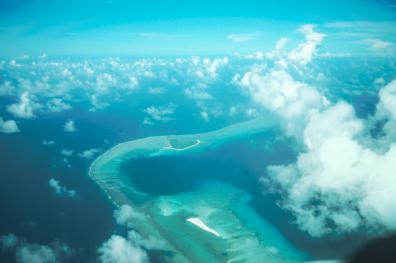 |
| On the 1st of March 1954, weighing 15 megatons, the biggest hydrogen bomb test in history left its mark. |
As far as the eye can see, beautiful azure waters stretch out beyond the shore. Chickens and pigs running wild, while islanders sit in the shade of palm trees and talk away idly. The children are having fun, diving for shellfish in the coral reef.
The islands name is Mejatto. In this island, with its circumference of approximately 2 kilometers, there are only about 300 people living here, but they are living in corrugated-iron shacks. Itis like nothingis changed since the time I came here 3 years ago.
My boat ran up to the beach, where the children ran to greet me when I got off. It looked like they hadnit had a visitor for a while.
Until 1985, this island, Mejatto, had been uninhabited. The people who moved here came from an island about 180 kilometers away, called Rongelap.
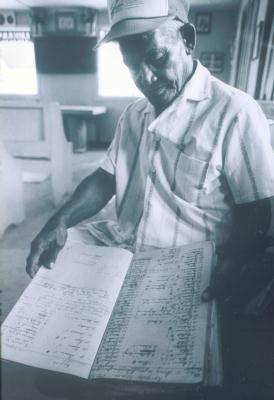 |
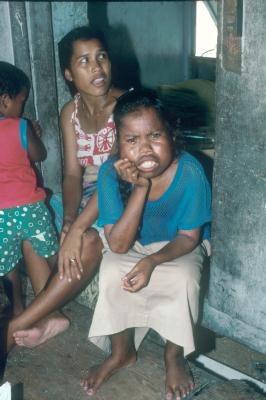 | |
| Mr. John Anjain keeps the only medical records on the Bikini Atoll nuclear test victims. Ebeye Island | Jule, 20 years old, has a deformed chin as a result of the radiation.
She has growth problems attributed to a thyroid gland disorder, and also suffers mental retardation.
She lost her mother to cancer. (Mejatto Island) |
In July 1946, the fourth atomic bomb was detonated by the USA in the Bikini Atoll, Marshall Islands, which is located in the Central Pacific.
This was one year after Hiroshima and Nagasaki. Over a period of 13 years, 66 nuclear tests were carried out in the area of the Bikini and Eniwetok Atolls.
On the 1st of March 1954, a hydrogen bomb test called iBravoi, with an effective yield of 15 megatons was carried out in the Bikini Atoll.
It was a thousand times as powerful as Hiroshima.
A Japanese tuna fishing boat, the iFifth Lucky Dragoni, and over 1000 other boats that were fishing in the area, suffered from the radioactive blast.
In Rongelap Island, about 180 kilometers away, the residents were not evacuated prior to the test, and so received the radioactive winds, tidal waves and the aptly named iDeath Ashesi.
The children played with and covered themselves in the white ashes that fell from the sky like a snow they had never experienced.
Soon, acute radiation disease started to cause severe vomiting, skin inflammation and hair loss.
After that, they were evacuated by US warships, and then 3 years later, in order to sign a security declaration, they were returned to Rongelap, accompanied by other islanders who had not been there at the time of the iBravoi test.
Only, the island was not safe for habitation, due to residual radioactivity.
Even those people who had not lived there at the time of the iBravoi test, still suffered internal radiation effects as a result of eating the indigenous coconuts, crabs, bread fruit and fish.
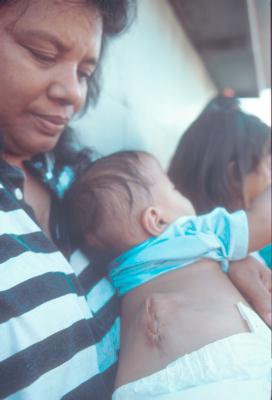 |
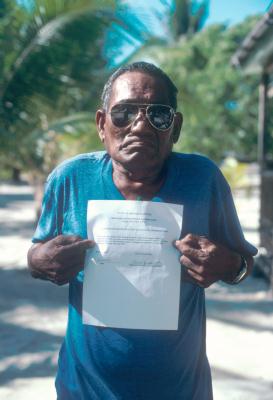 | |
| This child was operated on for hydrocephalus (A usually congenital condition in which an abnormal accumulation of fluid in the cerebral ventricles causes enlargement of the skull and compression of the brain, destroying much of the neural tissue). Ebeye Island. |
Edmond and some other islanders received this letter from the US government, stating their levels of radioactive contamination. This is evidence of experiments carried out on human subjects. |
Islanders died in rapid succession, falling to pregnancy abnormalities, thyroid cancer, leukemia and other illnesses.
In 1985, the Rongelap Islanders escaped from their hometown, which was filled with terrible radioactive contamination, to Mejatto Island, in Kwajalein Atoll, 200 kilometers away.
The village chief, Mr. John Anjain, meticulously kept records of the radiation victims. At the time, he had recorded the names of 86 victims. A number of the names are annotated with an X, which signifies that the person has either died or received a thyroid operation. By 1997, 38 people had already died.
Fewer than a quarter of the names remain without an X. A week before the test, a US soldier came to the island and said to the islanders that their lives were smaller than a fingernail, and held up his nail in front of Mr. Anjainis face. iThey used us as guinea pigsi said Mr. Anjain, pained. By that time, Rongelapis future had already been decided by the US amidst the rising competition in the nuclear development race.
Atnal Bores is 37 years old. Atnalis mother had been born in Rongelap and suffered the effects of the radiation while living there during the test. She also suffered internal radiation effects, and had three miscarriages. Even so, she has never been examined by the US DOEis (Department of Energy) doctors. iEver since it happened, they have never done anything for us. At the time, to those who were terribly burned by the radiation, they just told them to wash themselves in the ocean, they gave them no medicine. Every time I complained of such bad feelings, all they did was take blood and hair samples. The USA must admit they were and are responsible. They must give back to us our beautiful Rongelap Island. And we want a guarantee which is sufficient for all of the people who have sufferedi. In 1994, a report from Japanese doctors who went to examine the children showed abnormal increases of hepatitis B, meningocele (a severe form of spina bifida), anemia and suspicious cancers.
At that time, the US paid $150 million dollars to the islands that were affected, in an agreement between the Marshall government and the US, which freed the US from paying any further compensation to sufferers ever again.
As the sufferers grow older in age, so to does their longing to return to their homeland grow.
The Mejatto Islanders all say iwe want to return to our homei. Unfortunately, the contaminated southern islands still deny the hopes of the islanders.
The village chief, Mr. John Anjain, meticulously kept records of the radiation victims. At the time, he had recorded the names of 86 victims. A number of the names are annotated with an X, which signifies that the person has either died or received a thyroid operation. By 1997, 38 people had already died.
Fewer than a quarter of the names remain without an X. A week before the test, a US soldier came to the island and said to the islanders that their lives were smaller than a fingernail, and held up his nail in front of Mr. Anjainis face. iThey used us as guinea pigsi said Mr. Anjain, pained. By that time, Rongelapis future had already been decided by the US amidst the rising competition in the nuclear development race.
Atnal Bores is 37 years old. Atnalis mother had been born in Rongelap and suffered the effects of the radiation while living there during the test. She also suffered internal radiation effects, and had three miscarriages. Even so, she has never been examined by the US DOEis (Department of Energy) doctors. iEver since it happened, they have never done anything for us. At the time, to those who were terribly burned by the radiation, they just told them to wash themselves in the ocean, they gave them no medicine. Every time I complained of such bad feelings, all they did was take blood and hair samples. The USA must admit they were and are responsible. They must give back to us our beautiful Rongelap Island. And we want a guarantee which is sufficient for all of the people who have sufferedi. In 1994, a report from Japanese doctors who went to examine the children showed abnormal increases of hepatitis B, meningocele (a severe form of spina bifida), anemia and suspicious cancers.
At that time, the US paid $150 million dollars to the islands that were affected, in an agreement between the Marshall government and the US, which freed the US from paying any further compensation to sufferers ever again.
As the sufferers grow older in age, so to does their longing to return to their homeland grow.
The Mejatto Islanders all say iwe want to return to our homei. Unfortunately, the contaminated southern islands still deny the hopes of the islanders.
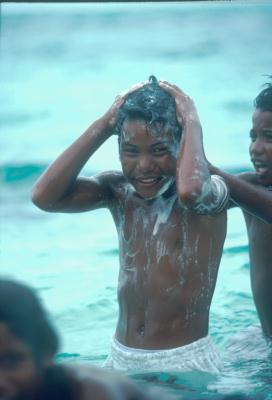 |
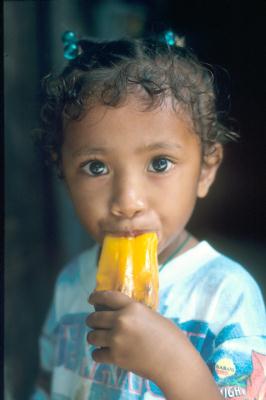 | |
| Clean rainwater is depended on for drinking. But, the precious rainwater cannot be used for bathing. | When the fruit of the native tako tree is boiled, it becomes very sweet. The children love the natural sweetness. (メジャット島) |